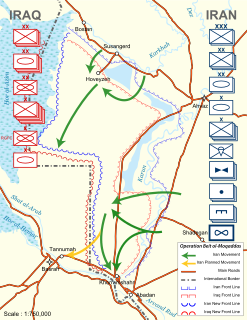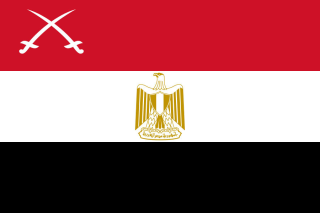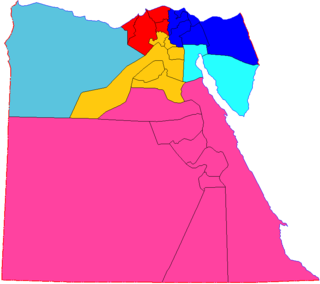A division is a large military unit or formation, usually consisting of between 6,000 and 25,000 soldiers.

A brigade is a major tactical military formation that typically comprises three to six battalions plus supporting elements. It is roughly equivalent to an enlarged or reinforced regiment. Two or more brigades may constitute a division.

The Italian Army is the land-based component of the Italian Armed Forces. The army's history dates back to the Italian unification in the 1850s and 1860s. The army fought in colonial engagements in China, Libya, Northern Italy against the Austro-Hungarian Empire during World War I, Abyssinia before World War II and in World War II in Albania, Balkans, North Africa, the Soviet Union, and Italy itself. During the Cold War, the army prepared itself to defend against a Warsaw Pact invasion from the east. Since the end of the Cold War, the army has seen extensive peacekeeping service and combat in Afghanistan and Iraq. Its best-known combat vehicles are the Dardo infantry fighting vehicle, the Centauro tank destroyer and the Ariete tank and among its aircraft the Mangusta attack helicopter, recently deployed in UN missions. The headquarters of the Army General Staff are located in Rome opposite the Quirinal Palace, where the president of Italy resides. The army is an all-volunteer force of active-duty personnel.

The Turkish Land Forces, or Turkish Army, is the main branch of the Turkish Armed Forces responsible for land-based military operations. The army was formed on November 8, 1920, after the collapse of the Ottoman Empire. Significant campaigns since the foundation of the army include suppression of rebellions in southeastern Turkey from the 1920s to the present day, combat in the Korean War, the 1974 Turkish invasion of Cyprus and the current Turkish involvement in the Syrian Civil War, as well as its NATO alliance against the USSR during the Cold War. The army holds the preeminent place within the armed forces. It is customary for the Chief of the General Staff of the Turkish Armed Forces to have been the Commander of the Turkish Land Forces prior to his appointment as Turkey's senior ranking officer. Alongside the other two armed services, the Turkish Army has frequently intervened in Turkish politics, a custom that is now regulated to an extent by the reform of the National Security Council. The current commander of the Turkish Land Forces is General Ümit Dündar.

The Syrian Army, officially the Syrian Arab Army (SAA), is the land force branch of the Syrian Armed Forces. It is the dominant military service of the four uniformed services, controlling the most senior posts in the armed forces, and has the greatest manpower, approximately 80 percent of the combined services. The Syrian Army originated in local military forces formed by the French after World War I, after France obtained a mandate over the region. It officially came into being in 1945, before Syria obtained full independence the following year.

Operation Beit-ol-Moqaddas or Operation Toward Beit-ol-Moqaddas was an Iranian operation conducted during the Iran–Iraq War. The operation was a success, as it achieved its standing aim of liberating Khorramshahr and pushed Iraqi troops back to the border. This operation, coupled with Operation Tariq-ol-Qods, and Operation Fath-ol-Mobin, succeeded in evicting Iraqi troops from southern Iran and gave Iran the momentum.
The 79th Group Army, formerly the 39th Group Army, is a military formation of roughly corps strength, of the People's Liberation Army of China. It is part of the Northern Theater Command. The 79th Group Army has more main battle tanks than any other group armies in China, as it was expected to counter the threat of Soviet armor in the Far East. Along with 38th Army stationed near Beijing, this unit is given the best equipment and training available.
The 113th Mechanized Infantry Division, now the 113th Medium Combined Arms Brigade, is a military formation of the People's Liberation Army of the People's Republic of China.

The 2nd Mechanized Infantry Division of the Infantry Corps of the Egyptian Army is a heavy infantry formation created after the Second World War.
This is the order of battle for Operation Badr, an Egyptian military operation that initiated the Yom Kippur War against Israel along the Suez Canal in the Sinai on October 6, 1973. As neither belligerent has released an official order of battle, this list remains incomplete and largely conjectural. An asterisk indicates Egyptian units that participated in the operation.

The Yemeni Republican Guard, formerly called the Strategic Reserve Forces between 2013 and 2016, is an elite formation of the Yemen Army. It is currently commanded by the former President Ali Abdullah Saleh's son, Ahmed Saleh. It was most notably involved in the 2011 Yemeni uprising, fighting in favour of the Saleh government. The unit was traditionally relied on as the backbone of the regime, and the unit was the best armed and trained in the armed forces. The Defence Ministry both overlooked and engaged in corruption with the unit in order to ensure the loyalty of the unit's leadership.
This is the order of battle for the Six-Day War between Israeli Forces and Arab Forces which consisted of Syrian, Egyptian and Jordanian Military Forces. The war took place on June 5–10, 1967.
The Second Field Army is a military formation of the Egyptian Army, formed in 1968. Army headquarters is at Ismailia. It is usually commanded by a field commander of Lieutenant-General rank of at least 34 years' service, and reports directly to the Army General Headquarters and General Staff.

The Western Military Region is one of the five military regions of the Egyptian Armed Forces and is headquartered in Marsa Matrouh.
The Central Military Region is one of the five military regions of the Egyptian Armed Forces and is headquartered in Cairo.
The Third Field Army is a field army of the Egyptian Army, with its headquarters in Suez. It is now part of the Unified Command of the area east of the canal (Egypt).

The Structure of the Egyptian Army depicted below focuses on operational organisation.

On October 8, 1950, 3rd Tank Division(Chinese: 战车第3师) was formed in Siping, Jilin province from 1st Independent Division, Northwestern Military Region.
The 193rd Division was created in February of 1949 under the Regulation of the Redesignations of All Organizations and Units of the Army, issued by Central Military Commission on November 1, 1948, basing on the 22nd Brigade, 8th Column, 2nd Army Group of Huabei Military Region. Its history could be traced to the famous 1st Division of Chinese Workers' and Peasants' Red Army.
The Cuban Revolutionary Army serve as the ground forces of Cuba. Formed in 1868 during the Ten Years' War, it was originally known as the Constitutional Cuban Army. Following the Cuban Revolution, the revolutionary military forces was reconstituted as the national army of Cuba by Fidel Castro in 1959. The army is a part of the Cuban Revolutionary Armed Forces which was founded around that time.









